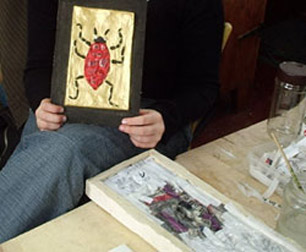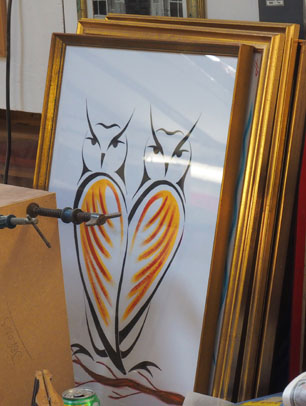
"The Cathja service is unique and has been described as 'a model of exceptionally good practice'."
Call us on
020 8560 8360
020 8560 8360






What is the Cathja service?
The Cathja provides a welcoming space that provides the opportunity for people to engage in being creative. The resources are geared to using wood in all its forms and there is a range of tools and machinery to use. Sculpture also forms a big part of the activity so there is a chance to use different materials too.
On Cathja anything is possible! There is absolutely no need for any practical experience or already discovered artistic talent. Some remarkable projects have been undertaken by people that had never made anything before.
It is expected that people will at first, need to just feel comfortable in the environment. They may take time to venture into the creative side of things. There is no pressure to 'produce'.
Everyone who uses Cathja has experienced mental health problems – usually over a long period of time. There are no assessments or reviews other than if requested by the individual themselves. However, there is a huge amount of wisdom within the Cathja user and staff group which has proved to be a source of support and understanding to all. Staff will accompany individuals to formal review meetings if requested.
The Cathja way of working has enabled many people to gain confidence and skills that have moved them away from the
'patient' role into a more active and positive way of being. The service is
based upon a few core principles:
- Users themselves determine the frequency and duration of their participation
- Users have real controls, rather than 'involvement' over the operation
- Numbers are restricted to 7–10 people each day
- There are no expectations of disclosures from users or 'clinical' assessments or reviews
- Activity and use of the facility is entirely determined by the individual, including the option not to engage in the 'work'
- Staff are enablers and supporters and do not present as mental health practitioners. However, as one radio commentator observed 'you are experts at not being experts'
- The environment and the creative activity are viewed as, and have proved to be, inherently healing. There is therefore no scrutiny, judgement or interpretation of the objects created.
On any day it is likely that there will be some people engaged in making utilitarian objects for themselves or others, some will be involved in more abstract creations and some will be involved in the social environment. All these roles are fluid, reflecting the current mood and disposition of those using the service. The culture of not 'having to perform' actually energises people rather than encouraging 'inactivity'. However, the concept of inactivity does not really apply
as 'being there' is taking part. Peer support is a key component of daily life on the Cathja.
There is no distinction between making utilitarian objects and artistic activity. Making the simplest object (eg a board with coat hooks) involves choices and decisions. How big should it be, what shape, painted or varnished, how many hooks etc, etc. The creativity and individual ownership of the object is identical to that involved with the making of a sculpture or carving. This dynamic of making an individual mark is a fundamental human function which is closely tied in with identity, confidence and connection with others. The Cathja process overcomes the barriers presented of 'I'm not artistic' or 'I'm hopeless at anything practical'.
It is therefore the combination of a non clinical, non judgmental small group environment where users have controls with a valuing of each person's innate creativity that has proved an astoundingly potent vehicle for healing.
There is no distinction between making utilitarian objects and artistic activity. Making the simplest object (eg a board with coat hooks) involves choices and decisions. How big should it be, what shape, painted or varnished, how many hooks etc, etc. The creativity and individual ownership of the object is identical to that involved with the making of a sculpture or carving. This dynamic of making an individual mark is a fundamental human function which is closely tied in with identity, confidence and connection with others. The Cathja process overcomes the barriers presented of 'I'm not artistic' or 'I'm hopeless at anything practical'.
It is therefore the combination of a non clinical, non judgmental small group environment where users have controls with a valuing of each person's innate creativity that has proved an astoundingly potent vehicle for healing.

